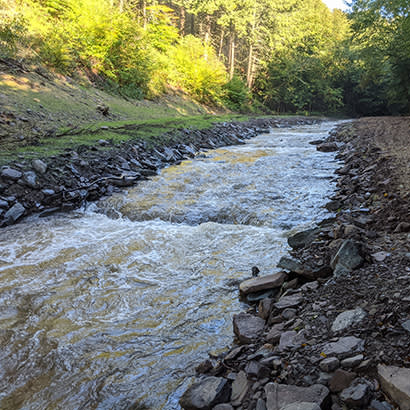
For an enhanced digital experience, read this story in the ezine.
“The Village of Delhi [New York] has experienced several extreme flood events over the years, including the floods of 1973, 1996, 2006, 2010 and 2011,” says Jessica Patterson, stream program technician at the Delaware County (New York) Soil and Water Conservation District.
Matthew Krzyston grew up in the Village of Delhi, less than a mile from Reservoir Park. “As a young kid, my parents would take me there to picnic and play in Steele Brook. It was a special place that people of all ages loved to visit,” he says. “However, during storm events, extreme eroding of the streambanks caused trees and clay sediment to fall into the stream. This created flooding in the village and made it impossible to even enter the park, and it was basically forgotten.”
Four decades later, Krzyston is a member of Delhi’s Joint Flood Mitigation Committee that, with the help of the U.S. Army Corps of Engineers, New York District, restored Steele Brook’s banks.
Steele Brook flows into the West Branch Delaware River, which is located in the heart of the Village of Delhi. The West Branch flows into the Cannonsville Reservoir, which supplies almost 97 billion gallons of water to the New York City water supply system.
To restore the streambank to reduce flooding and improve water quality, several agencies collaborated, including the Army Corps of Engineers, the New York State Department of Environmental Conservation, the New York City Department of Environmental Protection, the Village of Delhi, the Delaware County Department of Watershed Affairs, and the Delaware County Soil and Water Conservation District.
The streambank stabilization work included clearing the falling trees and debris from the 632-foot-long Steele Brook and its 21-foot-high slopes. Along the edges of the stream, loose stones were placed to slow down the stream and reduce potential damages downstream. Along the stream border, a stacked rock wall was built to prevent sediment from running off the slopes into the stream during storm events. Above the stacked rock wall, 8,414 feet of the bank that was eroding was revegetated with native plants, including native willow live stakes. The plant’s roots stabilize the soil and prevent the soil from running into the river. The vegetation also traps and absorbs sediment and pollutants, like harmful phosphorus and nitrogen particles, from entering the stream.
The stream also was realigned to include a floodplain, which prevents pollutants from entering the stream.
Preventing sediment from entering the stream is not only beneficial to the public’s water supply, but also to aquatic habitats. Clay sediment can reduce oxygen in the water, suffocating aquatic wildlife.
To further protect aquatic habitats, a mixture of deep and shallow water depths was created in the stream to support different types of fish and invertebrate life. Deep water, or pools, have slow moving water and are favorite places for certain species of fish, such as trout, to hang out. Shallow water, or riffles, are faster moving sections of a stream where rocks break the water’s surface, which allows oxygen to enter the water. These are good places for certain insects to live.
“Now the park is more accessible and more beautiful than it ever was before. I was excited to bring my boys — ages 13 and 15 — back to the same park where my parents had brought me. When we [visited], they were amazed that they had never seen this hidden gem that is right up the road,” says Krzyston.
According to the mayor of Delhi, picnic tables and grills will be placed in Reservoir Park to encourage not only locals to enjoy the area, but also visitors from New York City.
Besides the work recently completed on Steele Brook, the brook still has additional areas of erosion that will be worked on in the future. Patterson says, “There will be more projects in the future on several steep eroding banks. The work that was done recently served two goals — it stabilized the streambank to protect water quality and it improved an access road for future projects downstream.”
Krzyston says, “The flood commission members are very grateful to the Army Corps for the role they played in this project. While the project was designed to ensure public safety, the social and recreational benefits to the local population are immeasurable. There will be many family memories made at Reservoir Park.”
JoAnne Castagna, Ed.D., is Public Affairs Specialist and Writer for the U.S. Army Corps of Engineers, New York District.

